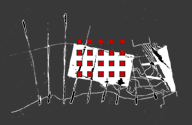
|
|
|||||||||||
 |
|||||||||||
|
|
|||||||||||
New
media and space
Despite the heterogeneity of the sources, the literature dealing with
the new media regularly comes back to the notion of space. Its language
is conspicuously peppered with spatial references: electronic space, cyberspace,
hyperspace, digital space, virtual space, information space, proto-space,
terminal space, para-space... Despite its qualification by a host of prefixes,
it is an all-purpose term that serves to illustrate the indeterminate
site of data. The promiscuous use of the term space implicates architecture
as a player, and architecture willingly assumes this given role, no matter
how improbably.
Telecommunications and architecture
The massive diffusion of information by means of the printed word was
supposedly going to replace architecture as a cultural expression. But,
driven by a strong survival instinct, architecture slowly expanded its
domain to encompass a whole industry of self-sustaining literature. But
now, in a world dominated by computers, telematics and television, architecture’s
self confidence is collapsing beneath the weight of its immaterial adversaries.
Apart from its noises about smart buildings, equipped with computer systems
to manage their lighting, their privacy and their security, architecture’s
efforts to make itself heard in the concert of electronic media have so
far been to little. A few projects do succeed in integrating the new technologies,
however: digital representations of building sites, formal computer modelling
strategies and what is in fact virtual design, the simulation of buildings.
But as architecture’s desire to represent technology grows, so this
technology itself becomes more difficult to represent. Advanced technology
today strives to dispense with the materiality of hardware, becoming invisible,
leaving only the interface and its effects.
Utopias of transparency
The technologies of electronics employ a rhetoric of liberty to affirm
the free access to information within the cyberspace. This unlimited access
abolishes distances and supposedly makes the world more transparent and
democratic. This discourse may remind us of the architects of the beginning
of this century when new materials and new construction techniques appeared.
A transparent world suddenly seemed possible with information available
to all, unimpeded by conventional spatial limitations. It was the age
of steel and glass towers, the very structure of which was to produce
a new form of socialization. The democratization of information was one
of the announced aims of the modernists. Here, glass, the ideal material,
was supposed to dematerialize walls, reveal what had hitherto been hidden
from view, encourage the emergence of truth and lead to a more open and
healthy society. In 1914, in his Glass Manifesto, Paul Scheerbart wrote
that the replacement of masonry by glass announced a new, limitless space
which would raise cultural levels’and lead, in the long run, to a
transformation of humanity.
Glass: visibility or control?
Public reactions to glass alternated between euphoria and paranoia. These
reactions announced a changeover from enthusiasm to suspicion, where the
democratic intentions of computer technologies were concerned. A technology
which promised the generalization of information could propagate misinformation
just as efficiently. The technological promise of democratic visibility
could be reversed, offering only improved surveillance. A technology which
guaranteed total freedom of movement would sooner or later have to accept
the restrictions and regulations which govern traditional space. Rather
than creating new, more open, social behavioral patterns, technology generated
new strategies of secrecy. At the beginning of this century, the democratic
ideals associated with glass gave rise to new fears, a preoccupation with
surveillance and control which raised the question: what liberty and on
which side of the pane of glass? Similarly, the liberty promised by the
new information technologies raises the question: what liberty and on
which side of the interface?